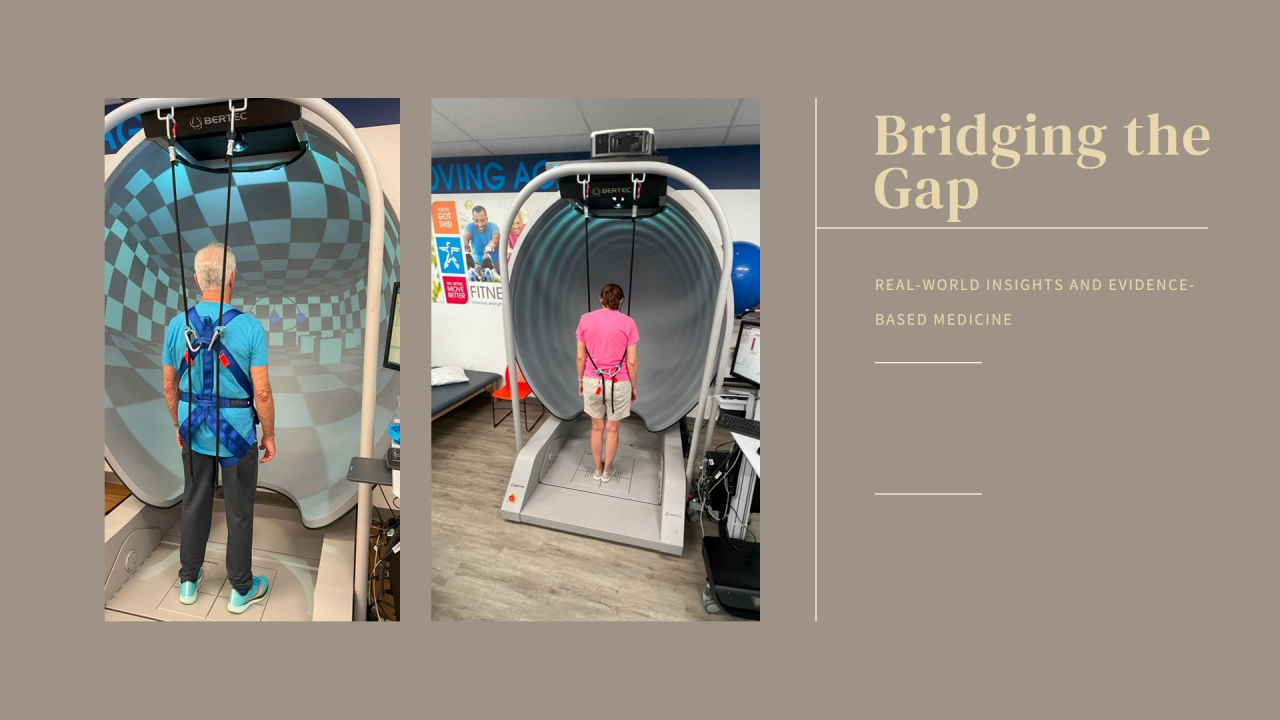
"Where's the Evidence?" Bridging the Gap Between Real-World Insights and Evidence-Based Medicine in Balance Assessment
Brian Werner, PT, MPT, Cert. MBR-L3, Cert. BPPV
Disclaimer: All posts are solely my own thoughts and do not represent those of my company - FYZICAL. They are based only on my understanding and may not be entirely accurate.
Introduction
While evidence-based medicine (EBM) remains a cornerstone of healthcare, it is crucial to acknowledge its limitations and embrace the valuable insights offered by real-world data (RWD). This is particularly true in balance assessment, where traditional standardized tests like the Sensory Organization Test (SOT) and the Clinical Test for Sensory Interaction on Balance (CTSIB) may need to capture the full complexity of real-world balance control.
As Gupta argued in the Journal of Clinical and Diagnostic Research, "Is evidence-based medicine a gold standard, or can it be influenced?" EBM, while valuable, can be influenced by various factors and may not always reflect the nuances of clinical practice (Gupta, 2016). This resonates deeply with the limitations of the SOT and CTSIB, which, in their original forms, rely on static assessments with a fixed head position. This approach must consider the dynamic nature of everyday balance, where individuals constantly adjust their head position and gaze to navigate their environment.
In my clinical practice, I have observed that incorporating head movements and positional changes during these assessments can reveal subtle balance deficits often masked in a static evaluation. This modified approach applied to both the SOT and CTSIB, is grounded in real-world evidence (RWE) principles, drawing upon direct observations and patient experiences to enhance diagnostic accuracy and treatment efficacy.
While some may question the lack of specific research on these modified protocols, it is essential to recognize that they are firmly rooted in established scientific principles and supported by a growing body of evidence.
The crucial role of the vestibular system in dynamic balance control.
This underscores the importance of incorporating head movements into balance assessments, as these movements directly challenge the vestibular system and its ability to integrate sensory information. By introducing head movements into the SOT and CTSIB, we gain a more comprehensive understanding of how the vestibular system contributes to the overall balance function (Cohen et al., 1993; Hirabayashi & Iwasaki, 1995).
The influence of visual and proprioceptive cues on balance when head position changes.
Research has shown that altering head position can significantly impact how the brain processes visual and proprioceptive information for balance control (Hirabayashi & Iwasaki, 1995). By incorporating head movements and positional changes into the SOT and CTSIB, we can assess the interplay between these sensory systems and identify potential deficits contributing to balance dysfunction.
领英推荐
It is critical to recognize the inherent limitations of traditional static balance assessments.
Studies have consistently shown that these tests may only partially capture balance control's dynamic and adaptive nature, leading to an incomplete understanding of an individual's true balance capabilities. Furthermore, while age-related declines in balance are evident in dynamic conditions, they may be less apparent in static tests, underscoring the need for more challenging assessments. By incorporating dynamic elements into the SOT and CTSIB, we can push the boundaries and move towards a more ecologically valid assessment that better reflects the demands of everyday life.
We can confidently assert this approach's value and clinical utility by integrating these research findings with the positive outcomes observed in patients undergoing the modified SOT and CTSIB. This highlights the synergistic relationship between real-world data and evidence-based medicine, where real-world observations can drive innovation and refinement of clinical practices. This should inspire us to continue seeking ways to improve our methods while EBM provides a framework for evaluating and validating these advancements.
References
Cohen, H., Blouin, J., & Alvarez, S. (1993). Head and trunk movements affect postural control in subjects with vestibular deficits. Journal of Vestibular Research, 3(3), 253-262.
Gupta, M. (2016). Is evidence-based medicine a gold standard, or can it be influenced? ResearchGate. Retrieved from
Hirabayashi, S., & Iwasaki, S. (1995). Effects of head movement on postural control during quiet stance in humans. Neuroscience Letters, 197(3), 165-168.
Mancini, M., & Horak, F. B. (2010). The relevance of clinical balance assessment tools to predict falls in older adults. European Journal of Physical and Rehabilitation Medicine, 46(2), 239–246.
Muchisky, M., Perry, S. D., Bohannon, R. W., & Trost, S. (1996). Relationship between static balance and functional performance in patients with stroke. Physical Therapy, 76(6), 617–622.
Whitney, S. L., Wrisley, D. M., & Marchetti, G. F. (2000). The effect of age on the sensory organization test in healthy adults. Journal of Geriatric Physical Therapy, 23(3), 11–18.*
MSPT Neuromuscular- University of Pittsburgh
2 周Very informative thank you for sharing!